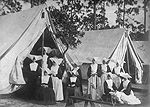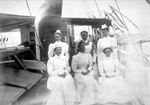The Cost of a Splendid Little War
Preparing for War
The Army Medical Department was unprepared to respond to the rush to war with Spain. Traditional American reluctance to fund a standing army led to volunteers swelling the ranks from 27,000 men to 275,000 in five months. Adequate supplies had not been bought to care for the men and the Quartermaster Corps was not properly shipping what had been bought. The Department did not have enough doctors to care for the troops as well as supervise the new volunteer physicians. The volunteer troops, lacking experience
 with army life, did not properly dispose of their waste which leaked into the camps' water supply to spread diseases. Many of the volunteers were already infected with disease when they arrived at Army camps. Soon typhoid, a bacterial disease spread by contaminated water and food and causing fever and intestinal bleeding, was rampant.
with army life, did not properly dispose of their waste which leaked into the camps' water supply to spread diseases. Many of the volunteers were already infected with disease when they arrived at Army camps. Soon typhoid, a bacterial disease spread by contaminated water and food and causing fever and intestinal bleeding, was rampant.
The Army set up large hospitals in each of the camps where soldiers were trained. Women were allowed to be nurses for the first time since the Civil War due to the shortage of men in the Hospital Corps. Dr. Anita McGee was commissioned as Assistant Surgeon General in charge of overseeing the nurses who enlisted in the Army. Over 1,700 women were hired as contract nurses for a limited period of time. Others volunteered their services with charitable groups such as the American Red Cross under the leadership of Clara Barton. After the war, the Army Nurse Corps was formally established. The United States Hospital Ship
Relief
 was one of several ships used for the care of sick and wounded soldiers. The
Relief
was a converted civilian ship with beds for 350 men. She carried an x-ray unit, an ice-making plant, a fresh-water distillery and medical supplies. She served as a hospital and transported sick troops in the Caribbean and Pacific.
was one of several ships used for the care of sick and wounded soldiers. The
Relief
was a converted civilian ship with beds for 350 men. She carried an x-ray unit, an ice-making plant, a fresh-water distillery and medical supplies. She served as a hospital and transported sick troops in the Caribbean and Pacific.



